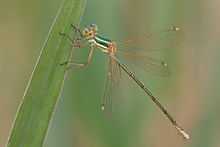Lestes barbarus
| Lestes barbarus | |
|---|---|
 | |
| Lestes barbarus, male | |
| Scientific classification | |
| Kingdom: | Animalia |
| Phylum: | Arthropoda |
| Class: | Insecta |
| Order: | Odonata |
| Family: | Lestidae |
| Genus: | Lestes |
| Species: | L. barbarus |
| Binomial name | |
| Lestes barbarus (Fabricius, 1798) | |
Lestes barbarus is a damselfly of the family Lestidae. It has the typical appearance of a Lestes damselfly; it has a metallic green body and at rest it holds its wings away from its body. Its common name in English is the Migrant Spreadwing but in Great Britain it is often known as the Southern Emerald Damselfly.
Distribution and habitat
L. barbarus is found across southern Europe in a band across Spain, France, Italy and Greece to India and Mongolia. It is less common in northern Europe, it breeds in the Netherlands in coastal dunes and is increasing in number. It is at the edge of its range in the Channel Islands, where it has been breeding since 1995. It is also found in north Africa; it gets its Latin name as the first specimen was found in Barbary, North Africa. It is a damselfly of still water and can be found in stagnant and slightly brackish water.
Status in Britain
This species was first recorded in Britain at Winterton Dunes, Norfolk on 30 July 2002 (Nobes 2003). There were 3 males. In 2003 & 2004, the species was again seen here and at Sandwich Bay, Kent (Forrest 2005). Although mainly a Mediterranean species, it has also been recorded in the Channel Islands.
Identification

This damselfly differs from the other European Lestes in having two-coloured pterostigmata which is diagnostic. The male abdominal appendage and female ovipositor are also characteristic and unlike those of L. sponsa or L. dryas. Like other Lestes both sexes are mainly metallic green and the wings are usually held well out from the body.
Immatures have pale pterostigmata and only develop the characteristic two-coloured pterostigmata when mature.
Behaviour
Flight period is from March to October in the south of its range but in north its main flight period is June to August. L. barbarus is very similar in its behaviour to L. sponsa but it is more likely to be found away from water. After mating the pair usually remain in tandem while the female lays eggs into waterside plants. L. barbarus overwinter as diapausing eggs and hatch into larvae in spring. The larvae develop very quickly, within 2 months and the adults emerge in late spring.
References
- Askew, R.R. (2004) The Dragonflies of Europe. (revised ed.) Harley Books. pp58–66. ISBN 0-946589-75-5
- d'Aguilar, J., Dommanget, JL., and Prechac, R. (1986) A field guide to the Dragonflies of Britain, Europe and North Africa. Collins. pp168–178. ISBN 0-00-219436-8
- Forrest, P. J. (2005) Southern Emerald Damselfly Lestes barbarus (Fabr.) at Sandwich Bay, Kent Atropos No. 24 pp. 24-25
- Gibbons, R.B., (1986). Dragonflies and Damselflies of Britain and Northern Europe. Country Life Books. ISBN 0-600-35841-0. pp54–62.
- Nobes, Geoff (2003) Southern Emerald Damselfly Lestes barbarus (Fabr.) - The First British Record Atropos No. 18 pp. 3-6
External links
- British dragonfly Society http://british-dragonflies.org.uk/species/southern-emerald-damselfly
- Photos Lestes barbarus site Dragonflies of Southern Urals http://www.odonata.su/index.php?name=db&op=viewtaxon&type=4&id=144
See also
| Wikimedia Commons has media related to Lestes barbarus. |
- List of damselflies of the world (Lestidae)
- Lestes dryas
- Lestes sponsa
- Lestes virens
- Lestes macrostigma
- Lestes viridis
- Lestes parvidens